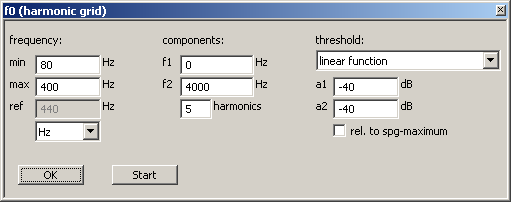F0 (harmonic grid) method
F0 (harmonic grid) method
This method uses a harmonic grid algorithm to detect the fundamental frequency of a harmonic tone (or a mixture of tones) in the FFT amplitude spectrum. A simple tracking algorithm is applied to the resulting values of consecutive frames. The result is the parameter function F0H(t) which can be stored in the DataSet.
min/max
Define the analysis and display fundamental frequency range in Hz.
ref
This is the reference frequency for Cent conversions.
Hz
Select the frequency unit for the display.
f1, f2
Define the frequency search component search range in Hz. This range can be outside the fundamental frequency range defined above.
harmonics
This is the minimum number of harmonic components building a harmonic tone. The value must be greater than or equal to 1.
threshold
Selects how the amplitude threshold for the component detection algorithm is computed. When a linear function threshold is specified, a linear function between the points (f1,a1) and (f2,a2) is computed and only peaks with amplitudes above this line are detected. For the threshold type cepstrum-smoothed spectrum, only peaks with amplitudes above the smoothed spectrum + offset are detected. The smoothed spectrum is an adaptive threshold and is very efficient for signals with a high dynamic range.
a1,a2
The threshold amplitudes for the threshold type linear function.
rel. to spg-maximum
The amplitude values are calculated relative to the spectrogram's maximum amplitude.
coefs
Number of coefficients for cepstrum smoothing.
offset
Amplitude offset for peak detection if the threshold is set to cepstrum-smoothed spectrum.
